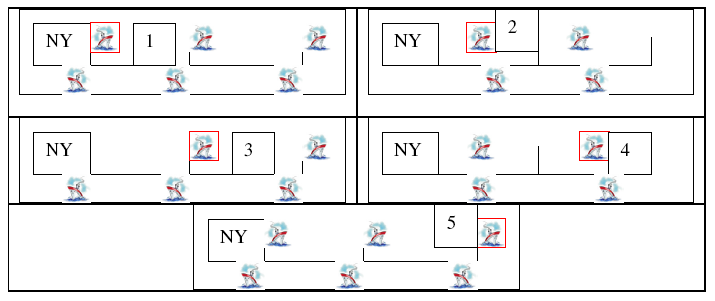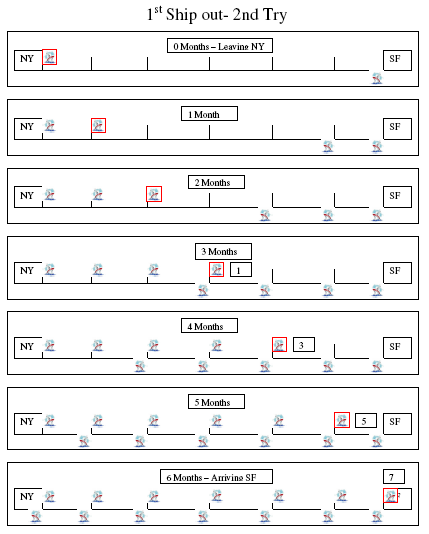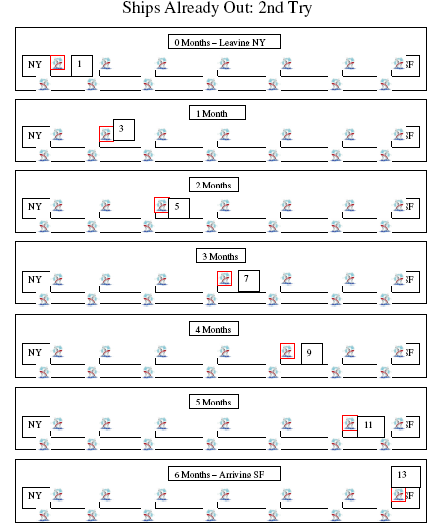Around the Horn POW
From ThePlaz.com
IAG 1H POW # 9: Around the Horn
A Microsoft Word version of this work is available here: Image:Around the Horn.doc
![]() A PDF version of this work is available here: Image:Around the Horn.pdf
A PDF version of this work is available here: Image:Around the Horn.pdf
Contents |
Problem Statement
Not necessary to do.
Process
This started as an easy POW, but it was tricky. I started by using pictures to find the solution. Your ship is outlined in red. SF also stands for San Francisco, and NY stands for New York. The line represents their journey and each mark is spaced one month apart. I knew there were two solutions to this problem. The first solution would be found if you were the first ship to leave in 7 months. The second solution would be found if there were already ships traveling between NY and SF, when you departed.
I tried to solve the first solution first. That was if my ship was the first one out in 7 or more months. I first created a picture like the one which is described above. I filled in the pictures with each one being a month apart. I ended up with 7 little pictures. They can be seen on page 3. I counted up in a little box each time I passed a ship. This was an easy way to solve the problem, (or so I thought) however I had to do a little thinking to realize that I needed to count the ship pulling out while I was arriving and the one arriving while I was leaving. That is what made the problem a bit [see later on] complicated.
I first found that if I was the first ship out in 7 months, I would pass 4 ships. I then noticed information from this chart.
| Months Since Leaving NY | Ships Passed | Ships Left SF who are closer to NY then me |
| 3 | 1 | 1 |
| 4 | 2 | 3 |
| 5 | 3 | 5 |
| 6 | 4 | 7 |
I started wondering, did I do something wrong. Would you also pass a ship in the middle of the month too. I saw that in 1 month 3 ships were now closer to NY then me, did I skip one? How could a ship just suddenly pass me. I decided to try to make a picture having the ships move half a month at a time. Here is a smaller model of a 2 month (in 1 case, 3 month) picture of the trip.
This picture seemed to explain a few things, my previous tally was wrong. I then made the chart on pg. 3 over again on pg. 5. My new total is 7 ships being passed if there were no other ships out on the water before I left.
(Before I figured out I passed ships during the month,) I then tried to find the other solution, where there are ships already out in the ocean. This was a little harder to draw and imagine. I made another picture and again I thought out the solution by counting up on each chart as I passed ships.
I found that I would pass 7 ships. I wondered if my answer was wrong (again). I then decided to make another chart, showing half-month intervals.
It seems that I was also wrong here. It must be that you pass 13 ships along your journey, because you pass 2 a month for 6 months and you pass 1 when you leave.
This problem is complicated to visualize and is tricky. To help explain my point a little better, I made PowerPoint animation to explain a sample 2 month journey. This shorter journey where you pass 5 boats also works with the formula mention above. You pass 2 boats a month for (in this case) a 2 month journey and you also pass 1 when you leave.
![]() A PowerPoint slideshow of this work is available here: Image:Around the Horn Demo.ppt
A PowerPoint slideshow of this work is available here: Image:Around the Horn Demo.ppt
Note: It doesn’t matter how many ships leave from NY, you can never pass them if you all travel at a constant speed.
Diagrams
Solution
If no ships left SF for 7 months, you would pass 7 of them. If there are ships already out, you would pass 13 ships on your way to SF.
Also, you need to wonder which solution is correct. I think it is unreal for there to be no ships coming from SF for 7 months. That is why I believe that 13 is the solution to this POW.
Extension
Not necessary to do.
Evaluation
Not necessary to do; This POW is trickier then it looks.






